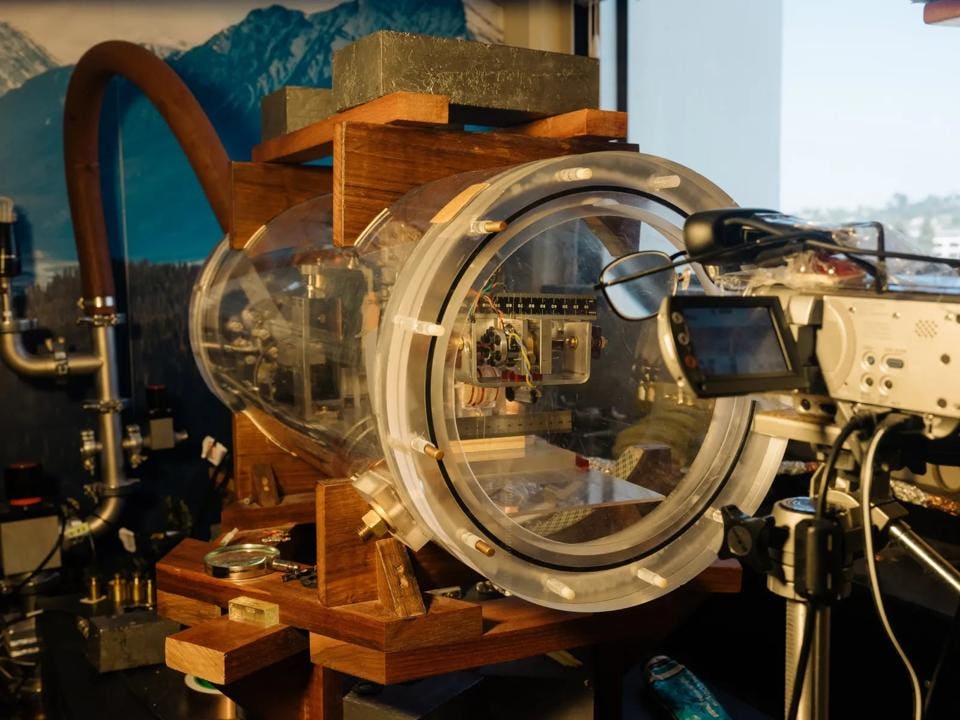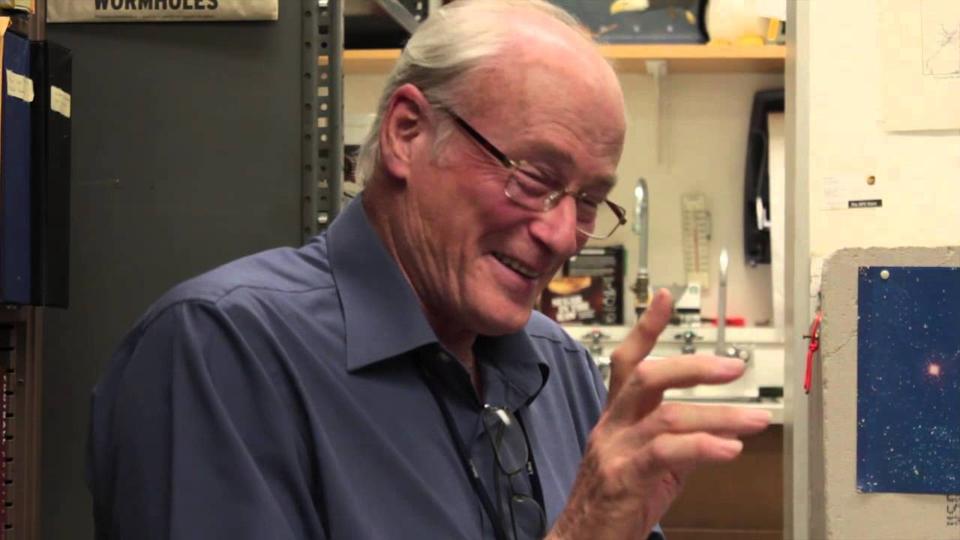Ultimate EV : This NASA-Funded Space Drive Requires No Fuel
John Koetsier
Senior Contributor
Consumer Tech
John Koetsier is a journalist, analyst, author, and speaker.
The testbed for James Woodard's Mach Effect propellantless space drive.
JAMES WOODWARD
Most spaceships burn rocket fuel to take off, manoeuvre, and — in SpaceX’s case — land. But what if you could power a spaceship entirely with electricity?
You’d have, essentially, a propellantless thruster.
That’s exactly the Mach Effect drive that James Woodward, physics professor emeritus at Fullerton, and a few colleagues have invented, with the help of a
NASA Innovative Advanced Concepts (NIAC) grant. The drive depends on physics described in Einstein’s theory of relativity via Austrian physicist Ernst Mach, is showing excellent promise in early testing, and is now in phase two testing.
It’s pretty much the holy grail of space science, because as Woodward says, this is a drive that could power not just local travel in our solar system, but interstellar travel.
How does it work?
Essentially, Woodward’s drive makes a stack of piezoelectric crystals alternately heavier and lighter by applying electric current to them. This isn’t magic and he’s not using New Age healing crystals; piezoelectric crystals expand and contract under the influence of electricity, and that means they’re interacting with what Einstein says are universal inertial fields in the universe, caused by gravity. If you can make something heavier one instant and lighter the next, you can then use the very same Newtonian every-reaction-causes-an-equal-and-opposite-reaction principle of rocket engines — which essential throw matter behind them to move forward — to create thrust.
This is apparently a
known effect and is based on “peer-reviewed, technically credible physics.”
The absolutely critical — and amazing — part is that you don’t permanently lose your crystals by actually throwing them away. You push them when heavy, pull them back when light, and dollar-cost-average your momentum to move forward.
“If you now have a double frequency mechanical oscillation, you can push on it when it’s more massive and pull it back when it’s less massive,” Woodward told me. “You’ve got propelling, but you don’t have to throw it over and say goodbye. You get to throw it over when it’s more massive and then because of this interaction with this inertial gravitational field, you can let it become less massive and then pull it back in.”
Woodward thinks each small Mach Effect drive unit could generate about a hundred millinewtons of force. Given that an average apple sitting on your desk exerts about a single newton of force on the desk, just due to the earth’s gravity, you’ll need a lot of them to power a spaceship.
Especially if it’s not in space already, in a zero-G environment.
As currently built, the Mach Effect engines are six-centimeter cubes: cubes just over two inches per side. By making them more efficient, Woodward says you’d get more power from each. And, you can stack as many of them as you want in, on, and around your space ship.
Then it’s just about how much electricity you can generate on your ship to feed the drives.
“If that back-of-the-envelope calculation is correct of 100 millinewtons or thereabouts, okay, you’re talking about ... ten newtons per kilowatt,” Woodward told me. “Ten newtons per kilowatt is approaching heavy lift ... you don’t need a chemical rocket to put these things in orbit when you get them working really well. You can just climb in ... and turn the thing on.”
Which would make a Mach Effect engine the ultimate EV, with the ability to transport you anywhere on the planet or the solar system ... and even beyond. Powering the engines and providing the electricity: probably a nuclear power plant.
That’s futuristic, of course.
Early applications, Woodward says, would be in satellites. Satellites currently use chemical rockets to maintain orbits and alignment; engines fueled by electricity could vastly extend their useful lifespans, and wouldn’t need huge amounts of power or scaling up. Solar panels would provide all needed fuel.
All of this, however, relies on peer review and replication of Woodward’s results, which is primarily what NASA’s most recent grant is all about. A variety of scientists and engineers around North America will be testing and hopefully independently verifying Woodward's results, including
Michelle Broyles, George Hathaway of
Hathaway Research in Ontario, Canada, and a NASA-contracted scientist, and
Mike McDonald, an aerospace engineer at the U.S. Naval Research Laboratory.
James Woodward, professor emeritus at Fullerton, and inventor of the Mach Effect space drive.
JAMES WOODWARD
Only when Woodward’s results are independently confirmed by multiple researchers, scientists, and engineers will NASA know if it has funded a potential winner, or a promising but ultimately dead-end technology.
Woodward, who is 79 and a cancer survivor with
relapsed Hodgkin's lymphoma, was a bit nonplussed when I asked him to project forward a few years, assuming his “gizmo,” as he calls it, works.
I asked him: where would you go with a functioning Mach Effect space ship?
“You know, I haven’t really thought about that very much,” he answered. “The obvious answer is to take a close look at the outer solar system, because this would make outer solar system travel relatively straightforward and not that expensive, you know. That would be the obvious place.”
And, if adequately tested, Woodward says, going to the relatively nearby red dwarf Proxima Centauri would be great.
“It’s a red dwarf and it’s got a habitable zone planet that might be worth taking a look at,” Woodward says.
Woodward has been working on the Mach Effect engine for most of his life, essentially, stimulated by a 1967 sighting of a satellite that, he thought was following an odd orbit, and a physical professor at NYU who told him that if he wanted to be the world’s top expert in something, to pick a really hard problem and be prepared to work on it for years.
But he doesn’t take much credit for all that effort.
“And I’d like to tell you that it was brilliance and genius and all the rest of that, but it wasn’t,” he says. “It was just dumb, damn luck.”
It’ll be amazing luck, plus some brilliance, and a whole lot of dogged persistence if others can replicate his experimental results and scale it up to useful sizes for satellites and vessel. That’s a long shot — tester Mike McDonald
gives it between a 1 in 10 to a 1 in 10 million chance (and to the higher end of that spectrum) — but it’s a shot.
And even a shot in the dark that could lead to a functional space drive is worth fighting for.
---
The interview vid.
---
Jamahir's comment : After reading the article you should watch the vid which is 45 mins long but interesting. I am not much conversant with physics but was able to get a sense of the importance of this device's invention and of other things that the professor said. One thing being its ability to propel the spacecraft at nearly light speed which makes interstellar travel possible but he speaks of practical issues with that. One thing I didn't understand was his mention of "Air sled" which would somehow be used to test the invention properly. This our American friend
@Hamartia Antidote or our BD-American friend
@Bilal9 can explain. The professor said that with this device powering a spacecraft there wouldn't be a need for a chemical rocket to lift the spacecraft and then once in space use this device for in-space propulsion. The device would be able to lift the spacecraft right from Earth. He then spoke of the device being used for flying cars. Wonderful ! Imagine flying taxis and buses and cargo aircraft using this invention.
@fitpOsitive @ps3linux @RealNapster @graphican @truthfollower
The nearest planet outside our solar system is around 40 trillion kilometres away. Imagine if someone had yo travel that distance.
If they that sort of technology for such a long journey, imagine what other technology they would have and not needing to visit this planet in person.
Please see above.













